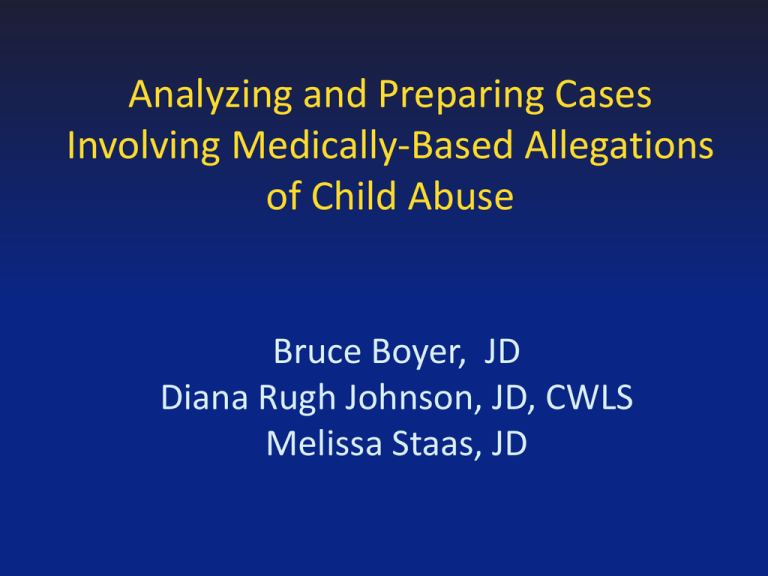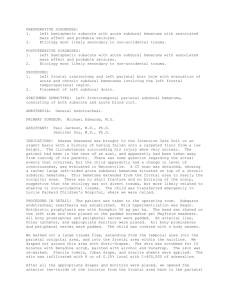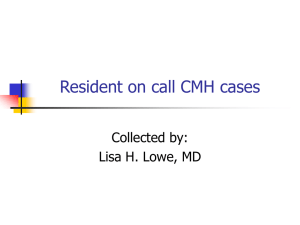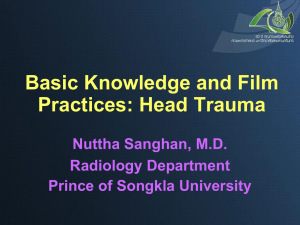
Analyzing and Preparing Cases
Involving Medically-Based Allegations
of Child Abuse
Bruce Boyer, JD
Diana Rugh Johnson, JD, CWLS
Melissa Staas, JD
Getting It Right
• Physical abuse cases are among our most
serious
• Removal of a child to foster care is sometimes
necessary, but always traumatic
• Reunification after an adjudication of physical
abuse can be very difficult to achieve
Case Analysis
• No up-front funds
• Attorney needs to know how to go over
his/her own case
• Attorney needs to read the medical records
• Attorney needs to understand the medical
facts on which the diagnosis was based
• Attorney needs to decide if experts need to be
consulted
Investigative Time Frame
• The hours leading up to the diagnosis are NOT
the most important.
• Obtain the child’s entire medical record
leading up to the injury in question
– Prenatal clinic
– Birth hospital
– Pediatrician
– Previous injuries
– Previous hospitalizations
– Urgent care facilities
Gathering Medical Records
• Obtain all medical records related to the injury
in question
– Medical Records Department
– Radiology Department
– Pathology Department
– Emergency Department
– Emergency Transport (ambulance, life flight)
Investigative Time Frame
• Obtain all medical records created after the
diagnosis of the injury in question
– Continued hospitalization
– Subsequent hospitalization
– Follow-up radiology
– Therapies
Learn the Terminology
Adeno-
gland
Cerebro-
cerebrum (part of brain)
Adreno-
adrenal gland
Cheilo-
lip (mouth)
Angio-
vessel
Chondro-
cartilage
Ano-
anus
Cilia-
hair
Arterio-
artery
Cleido-
collarbone
Arthro-
joint
Colpo-
vagina
Balano-
glans penis
Coxa-
hip
Blepharo-
eyelid
Cranio
head
Broncho-
bronchus (windpipe)
Cyto-
cell
Capit-
head
Derma-
skin
Cardi- or Cardio-
heart
Emia-
blood
Carpo-
wrist
Entero-
intestines
Cephalo-
head
Gastro-
stomach
Cerebello-
cerebellum (part of brain)
Gingivo-
gums
Know the Parts
Know the Directional Words
Build a Reference Library
Utilize on-line resources
Communicate with others who are
doing this work
• http://www.ga-innocenceproject.org/SBSSeminarMaterials-10.12.11.htm
Don’t be Intimidated by
the Medical Records
• Often, the medical facts on which the case
turns are written in plain English
– Identify potential problems and inconsistencies
before trial
– Child abuse consultation report contains a
compilation of information gathered from other
sources and other specialists
– Review the reports of each specialist
Example:
• Child Abuse Consult: “CT scan shows likely subdural
hematoma.”
• Radiology Report: “Hyperdense material along
posterior falx is nonspecific but may represent a
small amount of extraaxial blood products.
Recommend repeat imaging in 24-48 hours.”
• Radiology Report: Follow-up of previous
hyperdensity along posterior falx cerebri. Again
demonstrated as a thin area of high density. No
significant interval change, with stable thin
hyperdensity along the posterior falx, representing
either dural thickening or possibly a tiny amount of
subdural blood.
Example:
“5 day old neonate who was apparently well upon
discharge except for having some fussiness with diaper
changes that the parents attributed to his recent
circumcision, found to have R thigh swelling after dad
noticed baby was not moving his one leg when he
played with his feet. On x-ray, baby has an oblique,
displaced mid-shaft femur fracture with significant
swelling. The history of this neonate not being irritable
with diaper changes is not consistent with the fracture
being present at that point in time…This injury needs to
be considered non-accidental in nature, as there is not
an accidental mechanism to account for the injury.”
Don’t forget the basics of lawyering
• Investigate the family
– Scene investigation
– Detailed interview of parents
– Criminal history
– Social services history
– What kind of parents are they?
– Interview family members
– Interview neighbors & friends
– Interview the pediatrician
Case #1
Scene Investigation
Case #2
Interviewing Family
Case #3
Reviewing Post-Injury Records
2/17/10
• CPC report: 3 new rib fxs since discharge
– 3/1/10 CHEST XRAY
• There is a healed posterior L 7th rib fx once again
identified
• There is also a slightly bulbous medial aspect of the L
9th posterior rib
• Minimally displaced healing rib fxs of the R 5th, 6th, and
7th posterior ribs
3/1/10
– 3/8/10 CHEST XRAY
• There are healing rib fxs noted bilaterally
• The L posterior 7th rib fracture is an old one which was
reported previously
• The R-sided fractures are most conspicuous at the
posterior aspect of the 5th through 7th ribs
• Note is made that there also appear to be possible fxs
on the anterior aspect of the R 7th through 9th ribs
3/8/10
– 3/11/10 CHEST XRAY
• Healing rib fxs of the L 5th, 7th, and 9th and R 5th, 6th,
and 7th ribs demonstrate continued callous formation
3/11/10
– 3/23/10 SKELETAL SURVEY
• Multiple bilateral healing and healed rib fxs are seen
• The L 5th, 6th, and 9th ribs posteriorly show callus formation
• There is a contour irregularity of the 7th rib medially on the
L, which may represent an old, healed fx
• On the R, there are healing fxs of the 5th, 6th, and 7th
posterior ribs
• There are also healing fxs seen at the anterior tips of the 8th
and 9th ribs, which are more clearly seen on today’s study
and were not present on 3/1/10
• A small area of periosteal new bone formation is also seen
on the L 5th rib, separate from the healing fx, that was not
present previously and could represent a new healing fx
3/23/10
At Trial
• Make an opening statement
– Introduce your theory of the case
– Give the judge a road map to the verdict you want
• Know the medical records and the timeline of
the case like the back of your hand
• Prepare exhibits
– X-rays make great Power Point slides
– If dates are important, use a calendar
Example:
• Wrist fracture
Example:
DATE
TIME
.pdf PAGE
MED
RECORDS
PAGE
LOCATION
DESCRIPTION
2/8/10
1854
17288
17368
16536
16616
NO BRUISES
NO BRUISES
2/8/10
2300
17292
17373
16540
16621
NO BRUISES
NO BRUISES
2/9/10
0023
18168
17416
Right side of neck
No description
2/9/10
2330
18168
17416
Right side of neck
No description
2/10/10
0023
17751
17807
16999
17055
Right side of neck
No description
2/10/10
0121
17756
17814
17004
17062
NO BRUISES
NO BRUISES
2/11/10
0153
17772
17833
17020
17081
Groin, neck, chest
Purple
2/11/10
0918
17784
17848
17032
17096
Groin, neck, chest
Purple
2/11/10
1224
17789
17854
17037
17102
Groin, neck, chest
Purple
2/12/10
2212
18183
18212
17431
17460
No description
No description
2/13/10
2125
18192
18223
17440
17471
Left hand
Purple
2/14/10
0827
18196
18227
17444
17475
Left hand
Purple
2/14/10
2135
18202
18235
17450
17483
Left hand
Purple
2/15/10
0821
18472
18505
17720
17753
Left hand
Purple
2/15/10
1949
18477
18510
17725
17758
Right arm
Black
2/15/10
2211
18481
18515
17729
17763
Right arm
Purple
Example:
February 2010
Monday
1
No bruises noted
in chart
Tuesday
2
No bruises noted
in chart
Wednesday
Thursday
Friday
Saturday
Sunday
3
No bruises noted
in chart
4
No bruises noted
in chart
5
No bruises noted
in chart
6
No bruises noted
in chart
7
No bruises noted
in chart
8
No bruises noted
in chart
9
10
11
12
13
Right side of neck Right side of neck Groin, neck, chest No location given Left hand
No description
No description
Purple
No description
Purple
14
Left hand
Purple
15
Left hand
Right arm
Black & purple
16
No data
17
No data
18
No data
19
No bruises noted
in chart
20
No data
21
No data
22
HOME
23
HOME
24
HOME
25
HOME
26
HOME
27
HOME
28
HOME
Head Injuries
Exploring Potential Differential
Diagnoses, and Consulting the
Relevant Sub-specialists
Subdural Hematoma
• Treated immediately as a case suspicious for
abuse
• Child abuse pediatricians may conclude “likely
abuse” (i.e., “shaken baby syndrome” or
“abusive head trauma”) based solely on the
existence of a subdural hematoma
• However, subspecialists agree that an isolated
subdural hematoma is NOT pathognomonic
(i.e., diagnostic) for non-accidental trauma
Subdural Hematoma
• For the moment – let’s remove retinal
hemorrhages from the equation
• Isolated subdural hematoma could be due to:
– birth trauma,
– pre-existing medical condition,
– short-distance fall, or
– some combination of the above
Benign External Hydrocephalus
• Diagnosed via macrocephaly (head
circumference exceeding 90th percentile) and
radiological findings of enlarged extraaxial/subarachnoid spaces
• Pediatric neurosurgeons and pediatric
neurologists agree:
INFANTS WITH BEH ARE SUSCEPTIBLE TO
SUBDURAL HEMATOMAS FROM MINOR
TRAUMA, OR EVEN SPONTANEOUS BLEEDS
2 Examples of Peer-Reviewed,
Evidence-Based Studies
• Papasian & Frim, A Theoretical Model of Benign
External Hydrocephalus that Predicts a
Predisposition Towards Extra-Axial Hemorrhage
After Minor Head Trauma, Pediatric
Neurosurgery, 2000
• McNeely et al., Subdural Hematomas in Infants
with Benign Enlargement of the Subarachnoid
Spaces Are Not Pathognomonic for Child Abuse,
AmericaN Journal of Neuroradiology, 2006
How Do We Know that BEH May Be at
Play?
• May have been missed or overlooked by the
child abuse/child protection pediatrician
• Investigate:
– Pediatric records for increasing head
circumference
– Radiological findings and impressions
– Speak with the pediatric
neurosurgeon/neurologist
Translating the Radiological Jargon
These all mean the same thing:
• Benign enlargement of the subarachnoid space
(BESS)
• Extra axial spaces of infancy
• Benign enlargements of the extra-axial spaces
• Benign subdural collections of infancy
• Prominence of bilateral frontal extra-axial spaces
• Benign extra cerebral fluid collections
• Benign subdural effusions of infancy
Significance of the Presence of BEH
• It is a pre-existing medical condition that
predisposes infants to intracranial bleeding
from minor trauma, or even spontaneously
• Enlargement of the cerebrospinal fluid spaces
causes stretching of the bridging veins in the
subdural space, making them more vulnerable
• Subdural collections associated with BEH
mimics chronic subdural hematomas due to
non-accidental trauma
But What About Retinal Hemorrhages?
Non-accidental trauma is still not necessarily the
most likely explanation, particularly when
there has been:
• Incidental detection of subdural hematomas
and retinal hemorrhaging
• Minimal or complete absence of symptoms
• Absence of structural damage to the brain
Wading through the murky waters of
retinal hemorrhages
• Conflicting views regarding causation,
generally, and as to the role of morphology
and location
• Vigorous forces ≠ violent/abusive forces
• Need for photos and/or diagrams
What do the neurosurgeons say about
RHs?
In various specific cases, treating pediatric
neurosurgeons have opined and/or testified
that the RH in that specific case were
consistent with:
• Intracranial pressure
• Blood travelling up the optic nerve
• Birth trauma
Other explanations for subdural
hematomas
• Other medical conditions (blood disorders)
• Short-distance falls without pre-existing
conditions
Skull Fractures
Important to rule out a mis-reading of the
suture lines, which are prominent in infants












